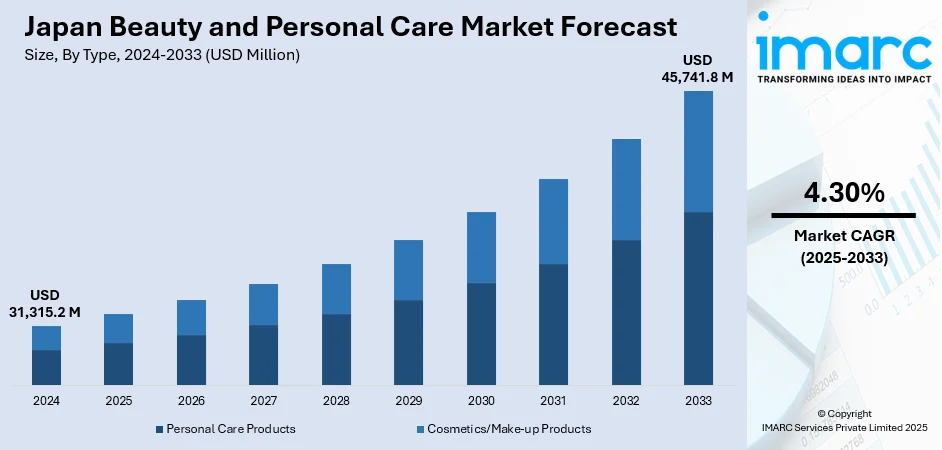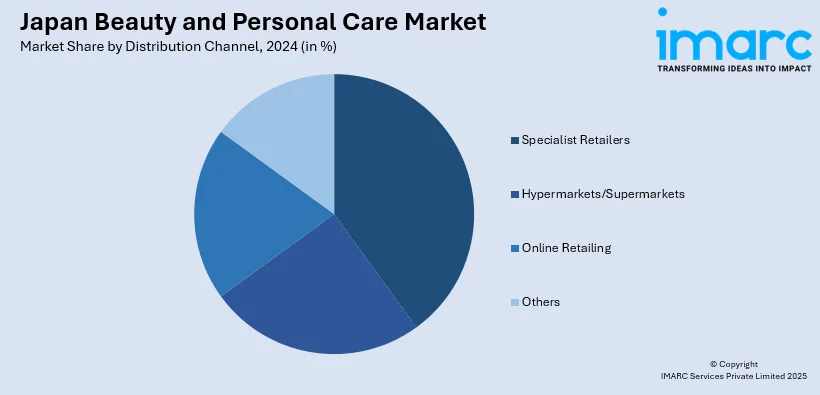
Japan Beauty and Personal Care Market Size, Share, Trends and Forecast by Type, Category, Distribution Channel, and Region, 2025-2033
Japan Beauty and Personal Care Market Overview:
The Japan beauty and personal care market size reached USD 31,315.2 Million in 2024. Looking forward, IMARC Group expects the market to reach USD 45,741.8 Million by 2033, exhibiting a growth rate (CAGR) of 4.30% during 2025-2033. The market is driven by rising health consciousness, aging population seeking anti-aging solutions, increased demand for natural and sustainable products, and growing influence of e-commerce and personalized beauty trends.
|
Report Attribute
|
Key Statistics
|
|---|---|
|
Base Year
|
2024
|
|
Forecast Years
|
2025-2033
|
|
Historical Years
|
2019-2024
|
| Market Size in 2024 | USD 31,315.2 Million |
| Market Forecast in 2033 | USD 45,741.8 Million |
| Market Growth Rate 2025-2033 | 4.30% |
Japan Beauty and Personal Care Market Trends:
Health and Wellness Consciousness
Consumers in Japan increasingly associate beauty with overall well-being, fueling the demand for health-conscious beauty and personal care products. This holistic approach includes choosing products that are free from harmful chemicals, have clean labels, and contain naturally derived or organic ingredients. Skincare, haircare, and body products that promote hydration, barrier protection, and skin microbiome balance are especially sought-after. Additionally, the Japan beauty and personal care market share is also fueled by the inner beauty supplements, such as collagen drinks and vitamin-enriched beverages, which are gaining traction, reflecting the integration of health and beauty routines. This health-focused mindset influences purchasing decisions and encourages brands to adopt a wellness-first narrative, blending beauty with nutrition, relaxation, and preventive care to meet modern consumer expectations. For instance, in September 2024, Kao Corporation intends to introduce KANEBO FUSION-ING SOLUTION, a fresh serum from its luxury brand KANEBO. Available for 13,000 yen (14,300 yen including tax) in Japan, FUSION-ING SOLUTION retains moisture and provides active ingredients that result in skin that is plump, soft, and glowing with vitality. Refills can be purchased for 12,500 yen (13,750 yen with tax included).

Demand for Natural, Sustainable, and Ethical Products
Environmental and ethical consciousness is rapidly growing among Japanese beauty consumers, especially younger generations. People are actively seeking personal care products that are cruelty-free, eco-friendly, vegan, and packaged sustainably. This trend is pushing both local and global brands to adopt greener practices, such as using recyclable materials, reducing plastic, and incorporating biodegradable ingredients, which is creating a positive impact on the Japan beauty and personal care market outlook. Organic beauty products, plant-based actives, and formulations free of parabens, sulfates, and synthetic fragrances are becoming mainstream. Ethical sourcing and transparent supply chains are also increasingly important. Consumers favor brands that align with their values, driving market innovation toward clean beauty. This shift is transforming product offerings and marketing strategies, particularly in skincare, haircare, and cosmetics.
Aging Population and Demand for Anti-Aging Solutions
Japan has one of the world’s oldest populations, and this demographic reality has a strong influence on the beauty and personal care industry. Consumers, particularly those aged 40 and above, prioritize skincare products that offer anti-aging benefits, like skin firming, wrinkle reduction, and brightening. As a result, brands are focusing on advanced formulations featuring collagen, hyaluronic acid, peptides, and retinol. Products with proven efficacy, scientific backing, and dermatological trust are highly valued. The aging demographic also looks for gentle, fragrance-free options that suit sensitive skin. This demand is shaping product development across categories, including facial creams, serums, eye care, and beauty devices, making anti-aging a core factor driving the Japan beauty and personal care market growth.
Japan Beauty and Personal Care Market Segmentation:
IMARC Group provides an analysis of the key trends in each segment of the market, along with forecasts at the regional level for 2025-2033. Our report has categorized the market based on type, category, and distribution channel.
Type Insights:
- Personal Care Products
- Hair Care Products
- Shampoo
- Conditioner
- Hair Oil
- Others
- Skin Care Products
- Facial Care Products
- Body Care Products
- Lip Care Products
- Bath and Shower Products
- Oral Care Products
- Toothbrushes and Replacements
- Toothpaste
- Mouthwashes and Rinses
- Others
- Men's Grooming Products
- Fragrances and Perfumes
- Hair Care Products
- Cosmetics/Make-up Products
- Facial Cosmetics
- Eye Cosmetic Products
- Lip and Nail Products
- Hair Styling and Coloring Products
The report has provided a detailed breakup and analysis of the market based on the type. This includes personal care products [hair care products (shampoo, conditioner, hair oil, others), skin care products(facial care products, body care products, lip care products), bath and shower products, oral care products (toothbrushes and replacements, toothpaste, mouthwashes and rinses, others) men's grooming products, and fragrances and perfumes], and cosmetics/make-up products (facial cosmetics, eye cosmetic products, lip and nail products, and hair styling and coloring products).
Category Insights:
- Premium Products
- Mass Products
A detailed breakup and analysis of the market based on the category have also been provided in the report. This includes premium products and mass products.
Distribution Channel Insights:

- Specialist Retailers
- Hypermarkets/Supermarkets
- Online Retailing
- Others
A detailed breakup and analysis of the market based on the distribution channel have also been provided in the report. This includes specialist retailers, hypermarkets/supermarkets, online retailing, and others.
Regional Insights:
- Kanto Region
- Kansai/Kinki Region
- Central/ Chubu Region
- Kyushu-Okinawa Region
- Tohoku Region
- Chugoku Region
- Hokkaido Region
- Shikoku Region
The report has also provided a comprehensive analysis of all the major regional markets, which include the Kanto Region, Kansai/Kinki Region, Central/ Chubu Region, Kyushu-Okinawa Region, Tohoku Region, Chugoku Region, Hokkaido Region, and Shikoku Region.
Competitive Landscape:
The market research report has also provided a comprehensive analysis of the competitive landscape. Competitive analysis such as market structure, key player positioning, top winning strategies, competitive dashboard, and company evaluation quadrant has been covered in the report. Also, detailed profiles of all major companies have been provided.
Japan Beauty and Personal Care Market News:
- In October 2024, Global home, beauty, and wellbeing company, Rituals Cosmetics, alongside prominent Asian brand operator and distributor, Bluebell Group, announced their collaboration for the first launch of the Rituals brand in Japan.
- In November 2024, South Korean skincare brand MEDIPEEL ramped up its expansion plans in Japan, to secure its presence in 750 stores by the end of the year, to strengthen its foothold in the vital beauty and personal care sector.
Japan Beauty and Personal Care Market Report Coverage:
| Report Features | Details |
|---|---|
| Base Year of the Analysis | 2024 |
| Historical Period | 2019-2024 |
| Forecast Period | 2025-2033 |
| Units | Million USD |
| Scope of the Report |
Exploration of Historical Trends and Market Outlook, Industry Catalysts and Challenges, Segment-Wise Historical and Future Market Assessment:
|
| Types Covered |
|
| Categories Covered | Premium Products, Mass Products |
| Distribution Channels Covered | Specialist Retailers, Hypermarkets/Supermarkets, Online Retailing, Others |
| Regions Covered | Kanto Region, Kansai/Kinki Region, Central/ Chubu Region, Kyushu-Okinawa Region, Tohoku Region, Chugoku Region, Hokkaido Region, Shikoku Region |
| Customization Scope | 10% Free Customization |
| Post-Sale Analyst Support | 10-12 Weeks |
| Delivery Format | PDF and Excel through Email (We can also provide the editable version of the report in PPT/Word format on special request) |
Key Questions Answered in This Report:
- How has the Japan beauty and personal care market performed so far and how will it perform in the coming years?
- What is the breakup of the Japan beauty and personal care market on the basis of type?
- What is the breakup of the Japan beauty and personal care market on the basis of category?
- What is the breakup of the Japan beauty and personal care market on the basis of distribution channel?
- What is the breakup of the Japan beauty and personal care market on the basis of region?
- What are the various stages in the value chain of the Japan beauty and personal care market?
- What are the key driving factors and challenges in the Japan beauty and personal care market?
- What is the structure of the Japan beauty and personal care market and who are the key players?
- What is the degree of competition in the Japan beauty and personal care market?
Key Benefits for Stakeholders:
- IMARC’s industry report offers a comprehensive quantitative analysis of various market segments, historical and current market trends, market forecasts, and dynamics of the Japan beauty and personal care market from 2019-2033.
- The research report provides the latest information on the market drivers, challenges, and opportunities in the Japan beauty and personal care market.
- Porter's five forces analysis assist stakeholders in assessing the impact of new entrants, competitive rivalry, supplier power, buyer power, and the threat of substitution. It helps stakeholders to analyze the level of competition within the Japan beauty and personal care industry and its attractiveness.
- Competitive landscape allows stakeholders to understand their competitive environment and provides an insight into the current positions of key players in the market.
Need more help?
- Speak to our experienced analysts for insights on the current market scenarios.
- Include additional segments and countries to customize the report as per your requirement.
- Gain an unparalleled competitive advantage in your domain by understanding how to utilize the report and positively impacting your operations and revenue.
- For further assistance, please connect with our analysts.
 Request Customization
Request Customization
 Speak to an Analyst
Speak to an Analyst
 Request Brochure
Request Brochure
 Inquire Before Buying
Inquire Before Buying




.webp)




.webp)












